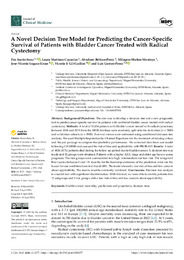Por favor, use este identificador para citar o enlazar este ítem:
https://hdl.handle.net/11000/35205Registro completo de metadatos
| Campo DC | Valor | Lengua/Idioma |
|---|---|---|
| dc.contributor.author | Sarrio Sanz, Pau | - |
| dc.contributor.author | MARTINESZ CAYUELAS, LAURA | - |
| dc.contributor.author | Beltran-Perez, Abraham | - |
| dc.contributor.author | Muñoz Montoya, Milagros | - |
| dc.contributor.author | Segura-Heras, José Vicente | - |
| dc.contributor.author | Gil-Guillen, Vicente F. | - |
| dc.contributor.author | GOMEZ PEREZ, LUIS | - |
| dc.contributor.other | Departamentos de la UMH::Estadística, Matemáticas e Informática | es_ES |
| dc.date.accessioned | 2025-01-23T20:37:26Z | - |
| dc.date.available | 2025-01-23T20:37:26Z | - |
| dc.date.created | 2024-04 | - |
| dc.identifier.citation | J. Clin. Med. 2024, 13, 2177. | es_ES |
| dc.identifier.issn | 2077-0383 | - |
| dc.identifier.uri | https://hdl.handle.net/11000/35205 | - |
| dc.description.abstract | The aim was to develop a decision tree and a new prognostic tool to predict cancer-specific survival in patients with urothelial bladder cancer treated with radical cystectomy. Methods: A total of 11,834n = 3945). Survival curves were estimated using conditional decision tree analysis. We used Multiple Imputation by Chained Equations for the treatment of missing values and the pec package to compare the predictive performance. We extracted data from our model following CHARMS and assessed the risk of bias and applicability with PROBAST. Results: A total of 4824 (41%) patients died during the follow-up period due to bladder cancer. A decision tree was made and12groups were obtained. Patients with a higher AJCC stage and older age have a worse prognosis. The risk groups were summarized into high, intermediate and low risk. The integrated Brier scores between 0 and 191 months for the bootstrap estimates of the prediction error are the lowest for our conditional survival tree (0.189). The model showed a low risk of bias and low concern about applicability. The results must be externally validated. Conclusions: Decision tree analysis is a useful tool with significant discrimination. With this tool, we were able to stratify patients into 12 subgroups and 3 risk groups with a low risk of bias and low concern about applicability. | es_ES |
| dc.format | application/pdf | es_ES |
| dc.format.extent | 12 | es_ES |
| dc.language.iso | eng | es_ES |
| dc.publisher | MDPI | es_ES |
| dc.rights | info:eu-repo/semantics/openAccess | es_ES |
| dc.rights.uri | http://creativecommons.org/licenses/by-nc-nd/4.0/ | * |
| dc.subject | bladder cancer | es_ES |
| dc.subject | mortality | es_ES |
| dc.subject | predictions and projections | es_ES |
| dc.subject | decision trees | es_ES |
| dc.subject.other | CDU::5 - Ciencias puras y naturales::50 - Generalidades sobre las ciencias puras | es_ES |
| dc.title | A NovelDecision Tree Model for Predicting the Cancer-Specific Survival of Patients with Bladder Cancer Treated with Radical Cystectomy | es_ES |
| dc.type | info:eu-repo/semantics/article | es_ES |
| dc.relation.publisherversion | https://doi.org/ 10.3390/jcm13082177 | es_ES |

Ver/Abrir:
2024_JCM (1).pdf
1,22 MB
Adobe PDF
Compartir:
 La licencia se describe como: Atribución-NonComercial-NoDerivada 4.0 Internacional.
La licencia se describe como: Atribución-NonComercial-NoDerivada 4.0 Internacional.
.png)